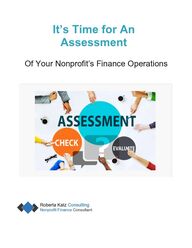
Return to flip book view
It’s Time for An Assessment Of Your Nonprofit’s Finance Operations
Copyright 2022. Roberta Katz Consulting www.rpkatzconsulting .com Preface Roberta Katz Why Does Your Nonprofit Need an Independent Assessment of Its Finance Operations? Interview each staff member and review the step-by-step procedures they follow in performing their functions. Document the procedures and include copies of documents and screenshots of software used. Evaluate the procedures and identify inefficiencies and lack of internal controls. Present a written report to management with a summary of the assessment and with findings and recommendations for improvements. Implement the recommendations provided with the guidance of the independent consultant. Five key areas an assessment will address: Workflow Optimization Internal Controls Implementation Digital Transformation Financial Statement Reporting Financial Audit Readiness How Is a Finance Assessment Conducted? To document its operating procedures and identify inefficiencies and lack of internal controls To provide an impartial evaluation that reviews its procedures critically The Management Letter it received from its external auditors cited weaknesses in its internal controls that it needs assistance in correcting Team members might be reluctant to disclose to their supervisors the challenges they face in performing their daily functions
Copyright 2022. Roberta Katz Consulting www.rpkatzconsulting .com Key Area #1: Workflow Optimization A nonprofit organization’s ability to maximize revenue and maintain control over their costs depends in part on efficient and effective financial procedures. This became clear during the recent pandemic when most nonprofits adjusted their procedures to accommodate remote working and changes in their workforce. 5 Steps to Optimize Workflow 1. Assess Current Procedures First, gain an understanding and document the step-by-step procedures each staff member performs in carrying out their duties. 2. Identify Key Areas of Inefficiencies Identify areas where the procedures break down and where backlogs are occurring. 3. Evaluate Internal Controls While reviewing procedures, ensure that there is an effective and efficient system of checks and balances. 4. Implement Process Improvements After identifying inefficiencies in procedures and deficiencies in internal controls, discuss changing the procedures with appropriate parties and implement them. 5. Train Staff and Maintain Oversight Explain to relevant staff why the changes in procedures are necessary. Then, maintain oversight to be sure the changes are being followed.
Copyright 2022. Roberta Katz Consulting www.rpkatzconsulting .com Key Area #2: Internal Controls Implementation An assessment of a nonprofit’s finance operations will assist in determining if there are sufficient internal controls i.e., checks and balances, in place to ensure the following: Efficient and Effective Operations Safeguarding of Assets Fraud Detection and Prevention Reliable Financial Reporting Compliance With Laws and Regulations
Copyright 2022. Roberta Katz Consulting www.rpkatzconsulting .com Key Area #3: Digital Transformation Implementing automated systems to replace manual ones, or upgrading outdated systems currently in use, maximizes productivity, increases transparency, facilitates document flow and approvals, and improves reporting accuracy and timeliness. Important considerations in implementing or upgrading automated systems: Establishing an efficient workflow and approval hierarchy (i.e., the sequential approval of transactions). Creating a Chart of Accounts that will result in the system generating financial reports that are meaningful to your organization. Assigning appropriate user access rights and monitoring them on a regular basis to minimize the chance of improper and unauthorized activity. Providing staff training to end users of the system that includes user manuals with instructions specific to your organization’s system. Distributing organizational policies for transactions that are processed through the automated system (e.g., Agency Credit Card Policy).
Copyright 2022. Roberta Katz Consulting www.rpkatzconsulting .com Key Area #4: Financial Statement Reporting ProcessTasksStaff RolesTimelineProcess: What tool(s) do you use to manage the month-end closing process (e.g., automated system, Excel spreadsheets)? Tasks: What specific tasks must be completed prior to closing the books and generating monthly financial statements? Staff Roles: Which staff member(s) are responsible for each task in the month-end close process? Timeline: When does each task have to be completed? When are the books closed for the month? When are the financial statements distributed? The key to generating timely and accurate monthly financial reports is having a formal month-end financial closing process. An assessment will review the following:
Copyright 2022. Roberta Katz Consulting www.rpkatzconsulting .com Key Area #5: Financial Audit Readiness Undergoing a financial audit with positive results and in a timely and cost-efficient manner requires proper and ongoing preparation throughout the year. This preparation includes: Maintaining organizational documents and significant contractsReconciling general ledger accounts monthly with adjustments made timelyMaintaining supporting documentation for substantial transactionsUpdating the Accounting Policies and Procedures ManualAddressing and correcting the auditor's Management Letter findings from the prior year's audit
Copyright 2022. Roberta Katz Consulting www.rpkatzconsulting .com Roberta Katz Consulting Nonprofit Finance Consultant Strengthening Nonprofit Organizations For more information www.rpkatzconsulting.com | robertapkatz@gmail.com | 917- 359-1158 Prior to starting her consulting business, Roberta Katz worked for fifteen years in senior financial management positions at medium and large nonprofit organizations overseeing the day-to-day operation of their finance departments and implementing processes and systems to strengthen the infrastructure of the departments. She currently provides her clients with expert guidance and tools using her extensive experience in the nonprofit sector.